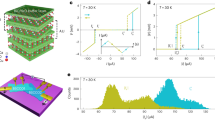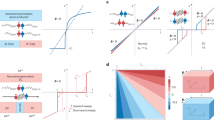Abstract
A classical battery converts chemical energy into a persistent voltage bias that can power electronic circuits. Similarly, a phase battery is a quantum device that provides a persistent phase bias to the wave function of a quantum circuit. It represents a key element for quantum technologies based on phase coherence. Here we demonstrate a phase battery in a hybrid superconducting circuit. It consists of an n-doped InAs nanowire with unpaired-spin surface states, that is proximitized by Al superconducting leads. We find that the ferromagnetic polarization of the unpaired-spin states is efficiently converted into a persistent phase bias φ0 across the wire, leading to the anomalous Josephson effect1,2. We apply an external in-plane magnetic field and, thereby, achieve continuous tuning of φ0. Hence, we can charge and discharge the quantum phase battery. The observed symmetries of the anomalous Josephson effect in the vectorial magnetic field are in agreement with our theoretical model. Our results demonstrate how the combined action of spin–orbit coupling and exchange interaction induces a strong coupling between charge, spin and superconducting phase, able to break the phase rigidity of the system.
This is a preview of subscription content, access via your institution
Access options
Access Nature and 54 other Nature Portfolio journals
Get Nature+, our best-value online-access subscription
$29.99 / 30 days
cancel any time
Subscribe to this journal
Receive 12 print issues and online access
$259.00 per year
only $21.58 per issue
Buy this article
- Purchase on Springer Link
- Instant access to full article PDF
Prices may be subject to local taxes which are calculated during checkout



Similar content being viewed by others
Data availability
The data that support the findings of this study are available from corresponding author E.S. upon reasonable request.
Code availability
The codes that support the findings of this study are available from corresponding author F.S.B. upon reasonable request.
References
Buzdin, A. Direct coupling between magnetism and superconducting current in the Josephson φ 0 junction. Phys. Rev. Lett. 101, 107005 (2008).
Bergeret, F. S. & Tokatly, I. V. Theory of diffusive φ 0 Josephson junctions in the presence of spin-orbit coupling. EPL 110, 57005 (2015).
Josephson, B. D. Possible new effects in superconductive tunnelling. Phys. Lett. 1, 251–253 (1962).
Golubov, A. A., Kupriyanov, M. Y. & Il’ichev, E. The current-phase relation in Josephson junctions. Rev. Mod. Phys. 76, 411–469 (2004).
Pal, S. & Benjamin, C. Quantized Josephson phase battery. EPL 126, 57002 (2019).
Yacoby, A., Schuster, R. & Heiblum, M. Phase rigidity and h/2e oscillations in a single-ring Aharonov-Bohm experiment. Phys. Rev. B 53, 9583–9586 (1996).
Strambini, E., Piazza, V., Biasiol, G., Sorba, L. & Beltram, F. Impact of classical forces and decoherence in multiterminal Aharonov-Bohm networks. Phys. Rev. B 79, 195443 (2009).
Ryazanov, V. V. et al. Coupling of two superconductors through a ferromagnet: evidence for a π junction. Phys. Rev. Lett. 86, 2427–2430 (2001).
Baek, B., Rippard, W. H., Benz, S. P., Russek, S. E. & Dresselhaus, P. D. Hybrid superconducting-magnetic memory device using competing order parameters. Nat. Commun. 5, 3888 (2014).
Gingrich, E. C. et al. Controllable 0–π Josephson junctions containing a ferromagnetic spin valve. Nat. Phys. 12, 564–567 (2016).
Silaev, M., Tokatly, I. & Bergeret, F. Anomalous current in diffusive ferromagnetic Josephson junctions. Phys. Rev. B 95, 184508 (2017).
Yokoyama, T. & Nazarov, Y. V. Magnetic anisotropy of critical current in nanowire Josephson junction with spin-orbit interaction. EPL 108, 47009 (2014).
Szombati, D. B. et al. Josephson φ 0-junction in nanowire quantum dots. Nat. Phys. 12, 568–572 (2016).
Assouline, A. et al. Spin-Orbit induced phase-shift in Bi2Se3 Josephson junctions. Nat. Commun. 10, 126 (2019).
Mayer, W. et al. Gate controlled anomalous phase shift in Al/InAs Josephson junctions. Nat. Commun. 11, 212 (2020).
Linder, J. & Robinson, J. W. A. Superconducting spintronics. Nat. Phys. 11, 307–315 (2015).
Giazotto, F. et al. A Josephson quantum electron pump. Nat. Phys. 7, 857–861 (2011).
Clarke, J. & Braginski, A. I. (eds) The SQUID Handbook (Wiley-VCH, 2004).
Sapkota, K. R., Maloney, F. S. & Wang, W. Observations of the Kondo effect and its coexistence with ferromagnetism in a magnetically undoped metal oxide nanostructure. Phys. Rev. B 97, 144425 (2018).
Dietl, T. & Ohno, H. Engineering magnetism in semiconductors. Mater. Today 9, 18–26 (2006).
Golod, T., Rydh, A. & Krasnov, V. M. Detection of the phase shift from a single Abrikosov vortex. Phys. Rev. Lett. 104, 227003 (2010).
Pita-Vidal, M. et al. A gate-tunable, field-compatible fluxonium. Preprint at arXiv:1910.07978 (2019).
Larsen, T. et al. Semiconductor-nanowire-based superconducting qubit. Phys. Rev. Lett. 115, 127001 (2015).
Guarcello, C. & Bergeret, F. Cryogenic memory element based on an anomalous Josephson junction. Phys. Rev. Appl. 13, 034012 (2020).
Reynoso, A. A., Usaj, G., Balseiro, C. A., Feinberg, D. & Avignon, M. Spin-orbit-induced chirality of Andreev states in Josephson junctions. Phys. Rev. B 86, 214519 (2012).
Virtanen, P., Bergeret, F. S., Strambini, E., Giazotto, F. & Braggio, A. Majorana bound states in hybrid two-dimensional Josephson junctions with ferromagnetic insulators. Phys. Rev. B 98, 020501 (2018).
Tiira, J. et al. Magnetically-driven colossal supercurrent enhancement in InAs nanowire Josephson junctions. Nat. Commun. 8, 14984 (2017).
Martelli, F. et al. Manganese-induced growth of GaAs nanowires. Nano Lett. 6, 2130–2134 (2006).
Strambini, E. et al. Revealing the magnetic proximity effect in EuS/Al bilayers through superconducting tunneling spectroscopy. Phys. Rev. Mater. 1, 054402 (2017).
Liu, Y. et al. Semiconductor-ferromagnetic insulator-superconductor nanowires: stray field and exchange field. Nano Lett. 20, 456–462 (2020).
Acknowledgements
The work of E.S. was supported by a Marie Curie Individual Fellowship (MSCA-IFEF-ST no. 660532-SuperMag). E.S., N.L. and F.G. acknowledge partial financial support from the European Union’s Seventh Framework Programme (FP7/2007-2013)/ERC grant no. 615187-COMANCHE. E.S., A.I., O.D., N.L., F.S.B. and F.G. were partially supported by the European Union’s Horizon 2020 research and innovation programme under grant agreement no. 800923 (SUPERTED). L.S. and V.Z. acknowledge partial support by the SuperTop QuantERA network and the FET Open And QC. I.V.T., C.S.F. and F.S.B. acknowledge financial support by the Spanish Ministerio de Ciencia, Innovacion y Universidades through projects no. FIS2014-55987-P, no. FIS2016-79464-P and no. FIS2017-82804-P and by the grant ‘Grupos Consolidados UPV/EHU del Gobierno Vasco’ (grant no. IT1249-19). A.B. thanks the CNR-CONICET cooperation programme ‘Energy conversion in quantum nanoscale hybrid devices’; the SNS-WIS joint laboratory QUANTRA, funded by the Italian Ministry of Foreign Affairs and International Cooperation; and the Royal Society through the international exchanges between the United Kingdom and Italy (grant no. IEC R2192166).
Author information
Authors and Affiliations
Contributions
E.S., A.I. and O.D. performed the experiment and analysed the data. R.C., C.S.F., C.G., I.V.T., A.B. and F.S.B. provided theoretical support. M.R., N.L. and O.D. fabricated the phase battery on the InAs nanowires grown by V.Z. and L.S.; E.S. conceived the experiment together with F.G., who supervised the project. E.S., A.I., I.V.T. and F.S.B. wrote the manuscript with feedback from all authors.
Corresponding authors
Ethics declarations
Competing interests
The authors declare no competing interests.
Additional information
Publisher’s note Springer Nature remains neutral with regard to jurisdictional claims in published maps and institutional affiliations.
Supplementary information
Supplementary Information
Supplementary Figs. 1–9, discussion and refs. 1–18.
Rights and permissions
About this article
Cite this article
Strambini, E., Iorio, A., Durante, O. et al. A Josephson phase battery. Nat. Nanotechnol. 15, 656–660 (2020). https://doi.org/10.1038/s41565-020-0712-7
Received:
Accepted:
Published:
Issue Date:
DOI: https://doi.org/10.1038/s41565-020-0712-7
This article is cited by
-
Sign reversal diode effect in superconducting Dayem nanobridges
Communications Physics (2023)
-
Sign reversal of the Josephson inductance magnetochiral anisotropy and 0–π-like transitions in supercurrent diodes
Nature Nanotechnology (2023)
-
Study the charging process of moving quantum batteries inside cavity
Scientific Reports (2023)
-
Josephson diode effect derived from short-range coherent coupling
Nature Physics (2023)
-
Phase biasing of a Josephson junction using Rashba–Edelstein effect
Nature Communications (2023)



